A Molecular Dynamics Study on the Tribological Performance of Imidazolium−Based Ionic Liquids Mixed with Oil in Comparison to Pure Liquids
Abstract
1. Introduction
2. Computational Details
2.1. Simulations Preparation and Force Field
2.2. Shear Simulations Details
3. Results and Discussion
3.1. Density Profiles
3.2. Velocity Profiles
3.3. Tribological Properties
4. Conclusions
Author Contributions
Funding
Institutional Review Board Statement
Informed Consent Statement
Data Availability Statement
Conflicts of Interest
References
- Cai, M.; Guo, R.; Zhou, F.; Liu, W. Lubricating a bright future: Lubrication contribution to energy saving and low carbon emission. Sci. China Technol. Sci. 2013, 56, 2888–2913. [Google Scholar] [CrossRef]
- Sasaki, S. Environmentally friendly tribology (Eco-tribology). J. Mech. Sci. Technol. 2010, 24, 67–71. [Google Scholar] [CrossRef]
- Baumann, A.; Bertsche, B. Coefficient of friction behavior of gear oils and significance for the meshing process of spur gears. Forsch. Ing. 2022, 86, 795–805. [Google Scholar] [CrossRef]
- Wang, W.; Li, P.; Sheng, S.; Tian, H.; Zhang, H.; Zhang, X. Influence of Hydrocarbon Base Oil Molecular Structure on Lubricating Properties in Nano-scale Thin Film. Tribol. Lett. 2019, 67, 111. [Google Scholar] [CrossRef]
- Lugt, P.M. Grease Lubrication in Rolling Bearings; John Wiley & Sons: Hoboken, NJ, USA, 2012. [Google Scholar]
- Askwith, T.C.; Cameron, A.; Crouch, R.F.; Saunders, O.A. Chain length of additives in relation to lubricants in thin film and boundary lubrication. Proc. R. Soc. Lond. Ser. A Math. Phys. Sci. 1966, 291, 500–519. [Google Scholar] [CrossRef]
- Kajdas, C.; Makowska, M.; Gradkowski, M. Tribochemistry of n-hexadecane in different material systems. Lubr. Sci. 2006, 18, 255–263. [Google Scholar] [CrossRef]
- Kajdas, C.; Makowska, M.; Gradkowski, M. Influence of temperature on the tribochemical reactions of hexadecane. Lubr. Sci. 2003, 15, 329–340. [Google Scholar] [CrossRef]
- Makowska, M.; Kajdas, C.; Gradkowski, M. Mechanism of boundary film formation from n-hexadecane. Lubr. Sci. 2004, 16, 101–110. [Google Scholar] [CrossRef]
- Montmitonnet, P.; Delamare, F.; Rizoulieres, B. Transfer layer and friction in cold metal strip rolling processes. Wear 2000, 245, 125–135. [Google Scholar] [CrossRef]
- Gao, J.; Luedtke, W.; Landman, U. Structure and solvation forces in confined films: Linear and branched alkanes. J. Chem. Phys. 1997, 106, 4309–4318. [Google Scholar] [CrossRef]
- Gao, J.; Luedtke, W.; Landman, U. Structures, solvation forces and shear of molecular films in a rough nano-confinement. Tribol. Lett. 2000, 9, 3–13. [Google Scholar] [CrossRef]
- Jabbarzadeh, A.; Harrowell, P.; Tanner, R. Low friction lubrication between amorphous walls: Unraveling the contributions of surface roughness and in-plane disorder. J. Chem. Phys. 2006, 125, 034703. [Google Scholar] [CrossRef] [PubMed]
- Tamura, H.; Yoshida, M.; Kusakabe, K.; Young-Mo, C.; Miura, R.; Kubo, M.; Teraishi, K.; Chatterjee, A.; Miyamoto, A. Molecular dynamics simulation of friction of hydrocarbon thin films. Langmuir 1999, 15, 7816–7821. [Google Scholar] [CrossRef]
- Cui, S.; Cummings, P.; Cochran, H. Molecular simulation of the transition from liquidlike to solidlike behavior in complex fluids confined to nanoscale gaps. J. Chem. Phys. 2001, 114, 7189–7195. [Google Scholar] [CrossRef]
- Zheng, X.; Zhu, H.; Kosasih, B.; Tieu, A.K. A molecular dynamics simulation of boundary lubrication: The effect of n-alkanes chain length and normal load. Wear 2013, 301, 62–69. [Google Scholar] [CrossRef]
- Jabbarzadeh, A.; Harrowell, P.; Tanner, R. Very low friction state of a dodecane film confined between mica surfaces. Phys. Rev. Lett. 2005, 94, 126103. [Google Scholar] [CrossRef]
- Jabbarzadeh, A.; Harrowell, P.; Tanner, R. Crystal Bridges, Tetratic Order, and Elusive Equilibria: The Role of Structure in Lubrication Films; ACS Publications: Washington, DC, USA, 2007; Volume 111, pp. 11354–11365. [Google Scholar]
- Jabbarzadeh, A.; Atkinson, J.D.; Tanner, R.I. The effect of branching on slip and rheological properties of lubricants in molecular dynamics simulation of Couette shear flow. Tribol. Int. 2002, 35, 35–46. [Google Scholar] [CrossRef]
- Berro, H.; Fillot, N.; Vergne, P. Molecular dynamics simulation of surface energy and ZDDP effects on friction in nano-scale lubricated contacts. Tribol. Int. 2010, 43, 1811–1822. [Google Scholar] [CrossRef]
- Kaur, G.; Kumar, H.; Singla, M. Diverse applications of ionic liquids: A comprehensive review. J. Mol. Liq. 2022, 351, 118556. [Google Scholar] [CrossRef]
- Song, J. Research Progress of Ionic Liquids as Lubricants. ACS Omega 2021, 6, 29345–29349. [Google Scholar] [CrossRef] [PubMed]
- Wu, J.; Zhu, J.; Mu, L.; Shi, Y.; Dong, Y.; Feng, X.; Lu, X. High load capacity with ionic liquid-lubricated tribological system. Tribol. Int. 2016, 94, 315–322. [Google Scholar] [CrossRef]
- Liu, X.; Zhou, F.; Liang, Y.; Liu, W. Tribological performance of phosphonium based ionic liquids for an aluminum-on-steel system and opinions on lubrication mechanism. Wear 2006, 261, 1174–1179. [Google Scholar] [CrossRef]
- Ueno, K.; Kasuya, M.; Watanabe, M.; Mizukami, M.; Kurihara, K. Resonance shear measurement of nanoconfined ionic liquids. Phys. Chem. Chem. Phys. 2010, 12, 4066–4071. [Google Scholar] [CrossRef] [PubMed]
- Zhou, F.; Liang, Y.; Liu, W. Ionic liquid lubricants: Designed chemistry for engineering applications. Chem. Soc. Rev. 2009, 38, 2590–2599. [Google Scholar] [CrossRef] [PubMed]
- Xiao, H.; Guo, D.; Liu, S.; Pan, G.; Lu, X. Film thickness of ionic liquids under high contact pressures as a function of alkyl chain length. Tribol. Lett. 2011, 41, 471–477. [Google Scholar] [CrossRef]
- Verma, C.; Quraishi, M.A. Ionic liquids-metal surface interactions: Effect of alkyl chain length on coordination capabilities and orientations. E-Prime—Adv. Electr. Eng. Electron. Energy 2022, 2, 100070. [Google Scholar] [CrossRef]
- Jiang, H.; Yu, Y.; Tang, W.; Zhou, R.; Shi, W.; Bai, L. A molecular dynamics study on the lubrication performance of ionic liquids. J. Mater. Sci. 2022, 57, 18874–18888. [Google Scholar] [CrossRef]
- Jin, C.-M.; Ye, C.; Phillips, B.S.; Zabinski, J.S.; Liu, X.; Liu, W.; Jean’ne, M.S. Polyethylene glycol functionalized dicationic ionic liquids with alkyl or polyfluoroalkyl substituents as high temperature lubricants. J. Mater. Chem. 2006, 16, 1529–1535. [Google Scholar] [CrossRef]
- Mirkhani, S.A.; Gharagheizi, F.; Ilani-Kashkouli, P.; Farahani, N. Determination of the glass transition temperature of ionic liquids: A molecular approach. Thermochim. Acta 2012, 543, 88–95. [Google Scholar] [CrossRef]
- Liu, J.; Wang, F.; Zhang, L.; Fang, X.; Zhang, Z. Thermodynamic properties and thermal stability of ionic liquid-based nanofluids containing graphene as advanced heat transfer fluids for medium-to-high-temperature applications. Renew. Energy 2014, 63, 519–523. [Google Scholar] [CrossRef]
- Minami, I.; Kamimura, H.; Mori, S. Thermo-oxidative stability of ionic liquids as lubricating fluids. J. Synth. Lubr. 2007, 24, 135–147. [Google Scholar] [CrossRef]
- Pisarova, L.; Gabler, C.; Dörr, N.; Pittenauer, E.; Allmaier, G. Thermo-oxidative stability and corrosion properties of ammonium based ionic liquids. Tribol. Int. 2012, 46, 73–83. [Google Scholar] [CrossRef]
- Amiril, S.A.S.; Rahim, E.A.; Syahrullail, S. A review on ionic liquids as sustainable lubricants in manufacturing and engineering: Recent research, performance, and applications. J. Clean. Prod. 2017, 168, 1571–1589. [Google Scholar] [CrossRef]
- Somers, A.E.; Howlett, P.C.; MacFarlane, D.R.; Forsyth, M. A review of ionic liquid lubricants. Lubricants 2013, 1, 3–21. [Google Scholar] [CrossRef]
- Cai, M.; Yu, Q.; Liu, W.; Zhou, F. Ionic liquid lubricants: When chemistry meets tribology. Chem. Soc. Rev. 2020, 49, 7753–7818. [Google Scholar] [CrossRef]
- Minami, I. Ionic liquids in tribology. Molecules 2009, 14, 2286–2305. [Google Scholar] [CrossRef]
- Palacio, M.; Bhushan, B. A review of ionic liquids for green molecular lubrication in nanotechnology. Tribol. Lett. 2010, 40, 247–268. [Google Scholar] [CrossRef]
- Perkin, S. Ionic liquids in confined geometries. Phys. Chem. Chem. Phys. 2012, 14, 5052–5062. [Google Scholar] [CrossRef]
- Arias-Pardilla, J.; Espinosa, T.; Bermudez, M. Electrochemistry in Ionic Liquids; Springer: Berlin/Heidelberg, Germany, 2015. [Google Scholar]
- Qu, J.; Truhan, J.; Dai, S.; Luo, H.; Blau, P. Ionic liquids with ammonium cations as lubricants or additives. Tribol. Lett. 2006, 22, 207–214. [Google Scholar] [CrossRef]
- Jiménez, A.; Bermúdez, M.; Carrion, F.; Martinez-Nicolas, G. Room temperature ionic liquids as lubricant additives in steel–aluminium contacts: Influence of sliding velocity, normal load and temperature. Wear 2006, 261, 347–359. [Google Scholar] [CrossRef]
- Jiménez, A.-E.; Bermúdez, M.-D. Imidazolium ionic liquids as additives of the synthetic ester propylene glycol dioleate in aluminium–steel lubrication. Wear 2008, 265, 787–798. [Google Scholar] [CrossRef]
- Mistry, K.; Fox, M.; Priest, M. Lubrication of an electroplated nickel matrix silicon carbide coated eutectic aluminium—Silicon alloy automotive cylinder bore with an ionic liquid as a lubricant additive. Proc. Inst. Mech. Eng. Part J J. Eng. Tribol. 2009, 223, 563–569. [Google Scholar] [CrossRef]
- Schneider, A.; Brenner, J.; Tomastik, C.; Franek, F. Capacity of selected ionic liquids as alternative EP/AW additive. Lubr. Sci. 2010, 22, 215–223. [Google Scholar] [CrossRef]
- Lu, R.; Nanao, H.; Kobayashi, K.; Kubo, T.; Mori, S. Effect of lubricant additives on tribochemical decomposition of hydrocarbon oil on nascent steel surfaces. J. Jpn. Pet. Inst. 2010, 53, 55–60. [Google Scholar] [CrossRef]
- Yao, M.; Liang, Y.; Xia, Y.; Zhou, F. Bisimidazolium Ionic Liquids as the High-performance antiwear additives in poly (ethylene glycol) for steel−steel contacts. ACS Appl. Mater. Interfaces 2009, 1, 467–471. [Google Scholar] [CrossRef] [PubMed]
- Cai, M.; Liang, Y.; Yao, M.; Xia, Y.; Zhou, F.; Liu, W. Imidazolium ionic liquids as antiwear and antioxidant additive in poly (ethylene glycol) for steel/steel contacts. ACS Appl. Mater. Interfaces 2010, 2, 870–876. [Google Scholar] [CrossRef]
- Qu, J.; Luo, H.; Chi, M.; Ma, C.; Blau, P.J.; Dai, S.; Viola, M.B. Comparison of an oil-miscible ionic liquid and ZDDP as a lubricant anti-wear additive. Tribol. Int. 2014, 71, 88–97. [Google Scholar] [CrossRef]
- Iglesias, P.; Bermúdez, M.; Carrión, F.; Martınez-Nicolás, G. Friction and wear of aluminium–steel contacts lubricated with ordered fluids-neutral and ionic liquid crystals as oil additives. Wear 2004, 256, 386–392. [Google Scholar] [CrossRef]
- Jiménez, A.; Bermúdez, M. Ionic liquids as lubricants of titanium–steel contact. Part 3. Ti6Al4V lubricated with imidazolium ionic liquids with different alkyl chain lengths. Tribol. Lett. 2010, 40, 237–246. [Google Scholar] [CrossRef]
- Itoh, T.; Watanabe, N.; Inada, K.; Ishioka, A.; Hayase, S.; Kawatsura, M.; Minami, I.; Mori, S. Design of alkyl sulfate ionic liquids for lubricants. Chem. Lett. 2009, 38, 64–65. [Google Scholar] [CrossRef]
- Minami, I.; Kita, M.; Kubo, T.; Nanao, H.; Mori, S. The tribological properties of ionic liquids composed of trifluorotris (pentafluoroethyl) phosphate as a hydrophobic anion. Tribol. Lett. 2008, 30, 215–223. [Google Scholar] [CrossRef]
- Wang, H.; Lu, Q.; Ye, C.; Liu, W.; Cui, Z. Friction and wear behaviors of ionic liquid of alkylimidazolium hexafluorophosphates as lubricants for steel/steel contact. Wear 2004, 256, 44–48. [Google Scholar] [CrossRef]
- Jiménez, A.; Bermúdez, M.; Iglesias, P.; Carrión, F.; Martínez-Nicolás, G. 1-N-alkyl-3-methylimidazolium ionic liquids as neat lubricants and lubricant additives in steel–aluminium contacts. Wear 2006, 260, 766–782. [Google Scholar] [CrossRef]
- Xie, G.; Luo, J.; Guo, D.; Liu, S. Nanoconfined ionic liquids under electric fields. Appl. Phys. Lett. 2010, 96, 043112. [Google Scholar] [CrossRef]
- Lopez Sanchez, F.; Otero, I.; Lopez, E.R.; Fernandez, J. Tribological properties of two bis (trifluoromethylsulfonyl) imide–based ionic liquids on steel–steel contact. Tribol. Trans. 2014, 57, 637–646. [Google Scholar] [CrossRef]
- Xia, Y.; Wang, S.; Zhou, F.; Wang, H.; Lin, Y.; Xu, T. Tribological properties of plasma nitrided stainless steel against SAE52100 steel under ionic liquid lubrication condition. Tribol. Int. 2006, 39, 635–640. [Google Scholar] [CrossRef]
- Lazarenko, D.; Khabaz, F. Interfacial dynamics and thermodynamics of imidazolium-based ionic liquids near iron surface. Langmuir 2022. submitted. [Google Scholar]
- Eder, S.J.; Vernes, A.S.; Betz, G. On the Derjaguin offset in boundary-lubricated nanotribological systems. Langmuir 2013, 29, 13760–13772. [Google Scholar] [CrossRef]
- Cornell, W.D.; Cieplak, P.; Bayly, C.I.; Gould, I.R.; Merz, K.M.; Ferguson, D.M.; Spellmeyer, D.C.; Fox, T.; Caldwell, J.W.; Kollman, P.A. A second generation force field for the simulation of proteins, nucleic acids, and organic molecules. J. Am. Chem. Soc. 1995, 117, 5179–5197. [Google Scholar] [CrossRef]
- Cheatham, T.E.; Cieplak, P.; Kollman, P.A. A Modified Version of the Cornell et al. Force Field with Improved Sugar Pucker Phases and Helical Repeat. J. Biomol. Struct. Dyn. 1999, 16, 845–862. [Google Scholar] [CrossRef] [PubMed]
- Wang, J.; Wolf, R.M.; Caldwell, J.W.; Kollman, P.A.; Case, D.A. Development and testing of a general amber force field. J. Comput. Chem. 2004, 25, 1157–1174. [Google Scholar] [CrossRef] [PubMed]
- Frisch, M.; Trucks, G.; Schlegel, H.B.; Scuseria, G.E.; Robb, M.A.; Cheeseman, J.R.; Scalmani, G.; Barone, V.; Mennucci, B.; Petersson, G. Gaussian 09; Revision D 01; Gaussian, Inc.: Wallingford, CT, USA, 2009. [Google Scholar]
- Bayly, C.I.; Cieplak, P.; Cornell, W.; Kollman, P.A. A well-behaved electrostatic potential based method using charge restraints for deriving atomic charges: The RESP model. J. Phys. Chem. 1993, 97, 10269–10280. [Google Scholar] [CrossRef]
- Zhang, Y.; Maginn, E.J. A Simple AIMD Approach to Derive Atomic Charges for Condensed Phase Simulation of Ionic Liquids. J. Phys. Chem. B 2012, 116, 10036–10048. [Google Scholar] [CrossRef] [PubMed]
- Maginn, E.J. Molecular simulation of ionic liquids: Current status and future opportunities. J. Phys. Condens. Matter 2009, 21, 373101. [Google Scholar] [CrossRef]
- Khabaz, F.; Zhang, Y.; Xue, L.; Quitevis, E.L.; Maginn, E.J.; Khare, R. Temperature Dependence of Volumetric and Dynamic Properties of Imidazolium-Based Ionic Liquids. J. Phys. Chem. B 2018, 122, 2414–2424. [Google Scholar] [CrossRef]
- Jakalian, A.; Bush, B.L.; Jack, D.B.; Bayly, C.I. Fast, efficient generation of high-quality atomic charges. AM1-BCC model: I. Method. J. Comput. Chem. 2000, 21, 132–146. [Google Scholar] [CrossRef]
- Jakalian, A.; Jack, D.B.; Bayly, C.I. Fast, efficient generation of high-quality atomic charges. AM1-BCC model: II. Parameterization and validation. J. Comput. Chem. 2002, 23, 1623–1641. [Google Scholar] [CrossRef]
- Daw, M.S.; Baskes, M.I. Semiempirical, quantum mechanical calculation of hydrogen embrittlement in metals. Phys. Rev. Lett. 1983, 50, 1285. [Google Scholar] [CrossRef]
- Daw, M.S.; Baskes, M.I. Embedded-atom method: Derivation and application to impurities, surfaces, and other defects in metals. Phys. Rev. B 1984, 29, 6443. [Google Scholar] [CrossRef]
- Lorentz, H.A. Ueber die Anwendung des Satzes vom Virial in der kinetischen Theorie der Gase. Ann. Phys. 1881, 248, 127–136. [Google Scholar] [CrossRef]
- Berthelot, D. Sur le mélange des gaz. Compt. Rendus 1898, 126, 1703–1706. [Google Scholar]
- Filippova, V.P.; Kunavin, S.A.; Pugachev, M.S. Calculation of the parameters of the Lennard-Jones potential for pairs of identical atoms based on the properties of solid substances. Inorg. Mater. Appl. Res. 2015, 6, 1–4. [Google Scholar] [CrossRef]
- Ta, T.D.; Tieu, A.K.; Zhu, H.; Kosasih, B. Adsorption of Normal-Alkanes on Fe(110), FeO(110), and Fe2O3(0001): Influence of Iron Oxide Surfaces. J. Phys. Chem. C 2015, 119, 12999–13010. [Google Scholar] [CrossRef]
- Hockney, R.W.; Eastwood, J.W. Computer Simulation Using Particles; CRC Press: Boca Raton, FL, USA, 1988. [Google Scholar]
- Plimpton, S. Fast parallel algorithms for short-range molecular dynamics. J. Comput. Phys. 1995, 117, 1–19. [Google Scholar] [CrossRef]
- Schneider, T.; Stoll, E. Molecular-dynamics study of a three-dimensional one-component model for distortive phase transitions. Phys. Rev. B 1978, 17, 1302–1322. [Google Scholar] [CrossRef]
- DÜNweg, B.; Paul, W. Brownian dynamics simulations without gaussian random numbers. Int. J. Mod. Phys. C 1991, 2, 817–827. [Google Scholar] [CrossRef]
- Morris, N.; Rahmani, R.; Rahnejat, H.; King, P.D.; Fitzsimons, B. Tribology of piston compression ring conjunction under transient thermal mixed regime of lubrication. Tribol. Int. 2013, 59, 248–258. [Google Scholar] [CrossRef]
- Taylor, R.I.; de Kraker, B.R. Shear rates in engines and implications for lubricant design. Proc. Inst. Mech. Eng. Part J J. Eng. Tribol. 2017, 231, 1106–1116. [Google Scholar] [CrossRef]
- Sorab, J. The Effect of Temperature, Pressure and Shear Rate on the Viscosity of Engine Oils; University of Houston: Houston, TX, USA, 1991. [Google Scholar]
- Lazarenko, D.; Khabaz, F. Thermodynamics and Rheology of Imidazolium-Based Ionic Liquid–Oil Mixtures: A Molecular Simulation Study. J. Phys. Chem. B 2021, 125, 5897–5908. [Google Scholar] [CrossRef]
- McCabe, C.; Cui, S.; Cummings, P.T.; Gordon, P.A.; Saeger, R.B. Examining the rheology of 9-octylheptadecane to giga-pascal pressures. J. Chem. Phys. 2001, 114, 1887–1891. [Google Scholar] [CrossRef]
- Kioupis, L.I.; Maginn, E.J. Impact of Molecular Architecture on the High-Pressure Rheology of Hydrocarbon Fluids. J. Phys. Chem. B 2000, 104, 7774–7783. [Google Scholar] [CrossRef]
- Fedorov, M.V.; Kornyshev, A.A. Towards understanding the structure and capacitance of electrical double layer in ionic liquids. Electrochim. Acta 2008, 53, 6835–6840. [Google Scholar] [CrossRef]
- Jurado, L.A.; Espinosa-Marzal, R.M. Insight into the Electrical Double Layer of an Ionic Liquid on Graphene. Sci. Rep. 2017, 7, 4225. [Google Scholar] [CrossRef] [PubMed]
- Perkin, S.; Crowhurst, L.; Niedermeyer, H.; Welton, T.; Smith, A.M.; Gosvami, N.N. Self-assembly in the electrical double layer of ionic liquids. Chem. Commun. 2011, 47, 6572–6574. [Google Scholar] [CrossRef]
- Prentice, I.J.; Liu, X.; Nerushev, O.A.; Balakrishnan, S.; Pulham, C.R.; Camp, P.J. Experimental and simulation study of the high-pressure behavior of squalane and poly-α-olefins. J. Chem. Phys. 2020, 152, 074504. [Google Scholar] [CrossRef]
- Bair, S.; Winer, W.O. Discussion: “Experimental Investigation of the Shear Strength of Lubricants Subjected to High Pressure and Temperature”. J. Tribol. 1990, 112, 744–746. [Google Scholar] [CrossRef]
- Israelachvili, J.N. Measurement of the viscosity of liquids in very thin films. J. Colloid Interface Sci. 1986, 110, 263–271. [Google Scholar] [CrossRef]
- Thompson, P.A.; Robbins, M.O. Shear flow near solids: Epitaxial order and flow boundary conditions. Phys. Rev. A 1990, 41, 6830–6837. [Google Scholar] [CrossRef]
- Ntim, S.; Sulpizi, M. Effects of shear flow on the structure and dynamics of ionic liquids in a metallic nanoconfinement. Phys. Chem. Chem. Phys. 2021, 23, 24357–24364. [Google Scholar] [CrossRef]
- Martinie, L.; Vergne, P. Lubrication at Extreme Conditions: A Discussion about the Limiting Shear Stress Concept. Tribol. Lett. 2016, 63, 21. [Google Scholar] [CrossRef]
- Amorim, P.M.; Ferraria, A.M.; Colaço, R.; Branco, L.C.; Saramago, B. Imidazolium-based ionic liquids used as additives in the nanolubrication of silicon surfaces. Beilstein J. Nanotechnol. 2017, 8, 1961–1971. [Google Scholar] [CrossRef]
- He, Y.; Li, H.; Qu, C.; Cao, W.; Ma, M. Recent understanding of solid-liquid friction in ionic liquids. Green Chem. Eng. 2021, 2, 145–157. [Google Scholar] [CrossRef]
- Li, H.; Ma, L.; Wen, P.; Han, Y.; Dong, R.; Fan, M. Molecular structure insight into the tribological behavior of sulfonate ionic liquids as lubricants for titanium alloys. J. Mol. Liq. 2022, 357, 119082. [Google Scholar] [CrossRef]
- Fan, M.; Jin, Y.; Han, Y.; Ma, L.; Li, W.; Lu, Y.; Zhou, F.; Liu, W. The effect of chemical structure on the tribological performance of perfluorosulfonate ILs as lubricants for Ti-6Al-4V tribopairs. J. Mol. Liq. 2021, 321, 114286. [Google Scholar] [CrossRef]
- Mehrnia, S.; Pelz, P.F. Slip length of branched hydrocarbon oils confined between iron surfaces. J. Mol. Liq. 2021, 336, 116589. [Google Scholar] [CrossRef]
- Webber, R.M. Low temperature rheology of lubricating mineral oils: Effects of cooling rate and wax crystallization on flow properties of base oils. J. Rheol. 1999, 43, 911–931. [Google Scholar] [CrossRef]
- Jabbarzadeh, A.; Atkinson, J.; Tanner, R. Effect of the wall roughness on slip and rheological properties of hexadecane in molecular dynamics simulation of Couette shear flow between two sinusoidal walls. Phys. Rev. E 2000, 61, 690. [Google Scholar] [CrossRef]
- Zheng, X.; Zhu, H.; Tieu, A.K.; Kosasih, B. Roughness and lubricant effect on 3D atomic asperity contact. Tribol. Lett. 2014, 53, 215–223. [Google Scholar] [CrossRef]

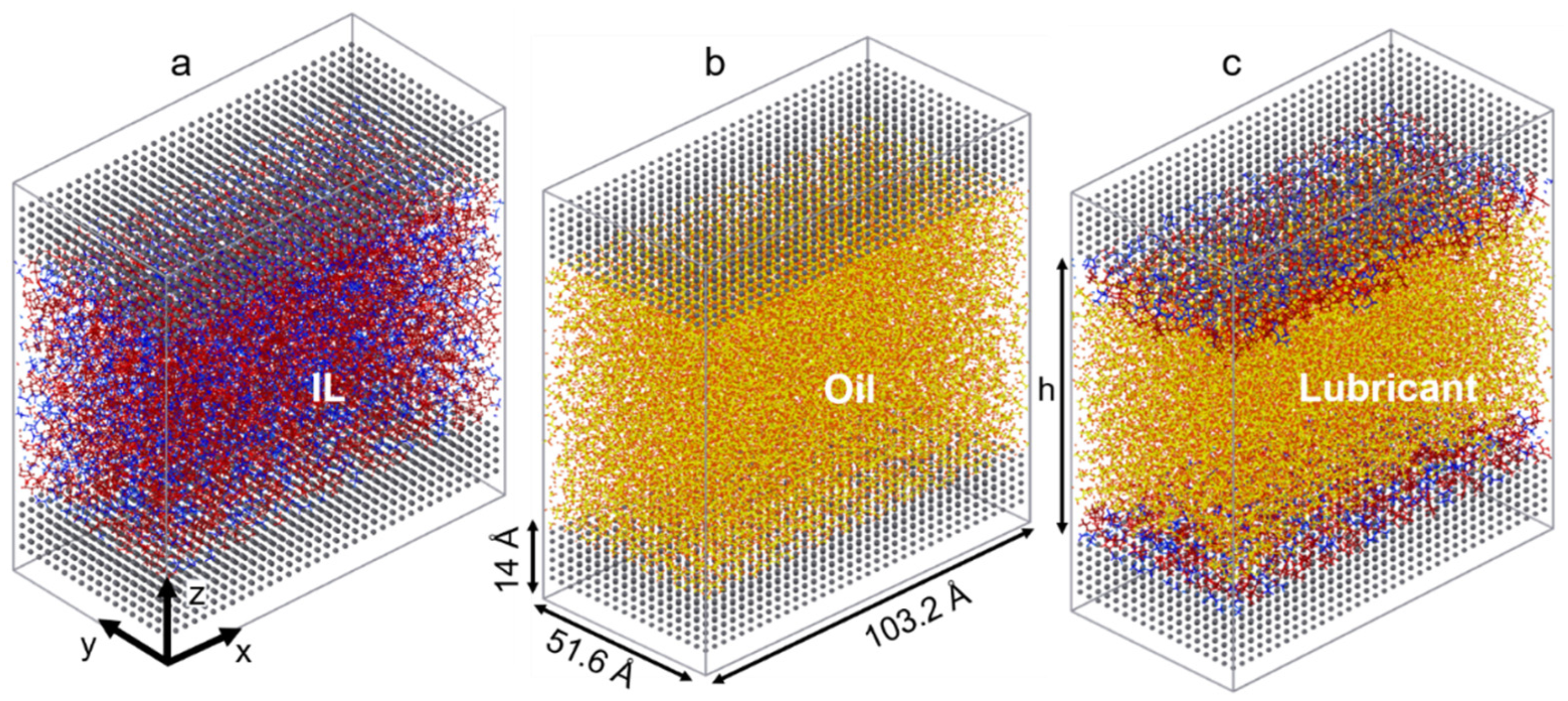
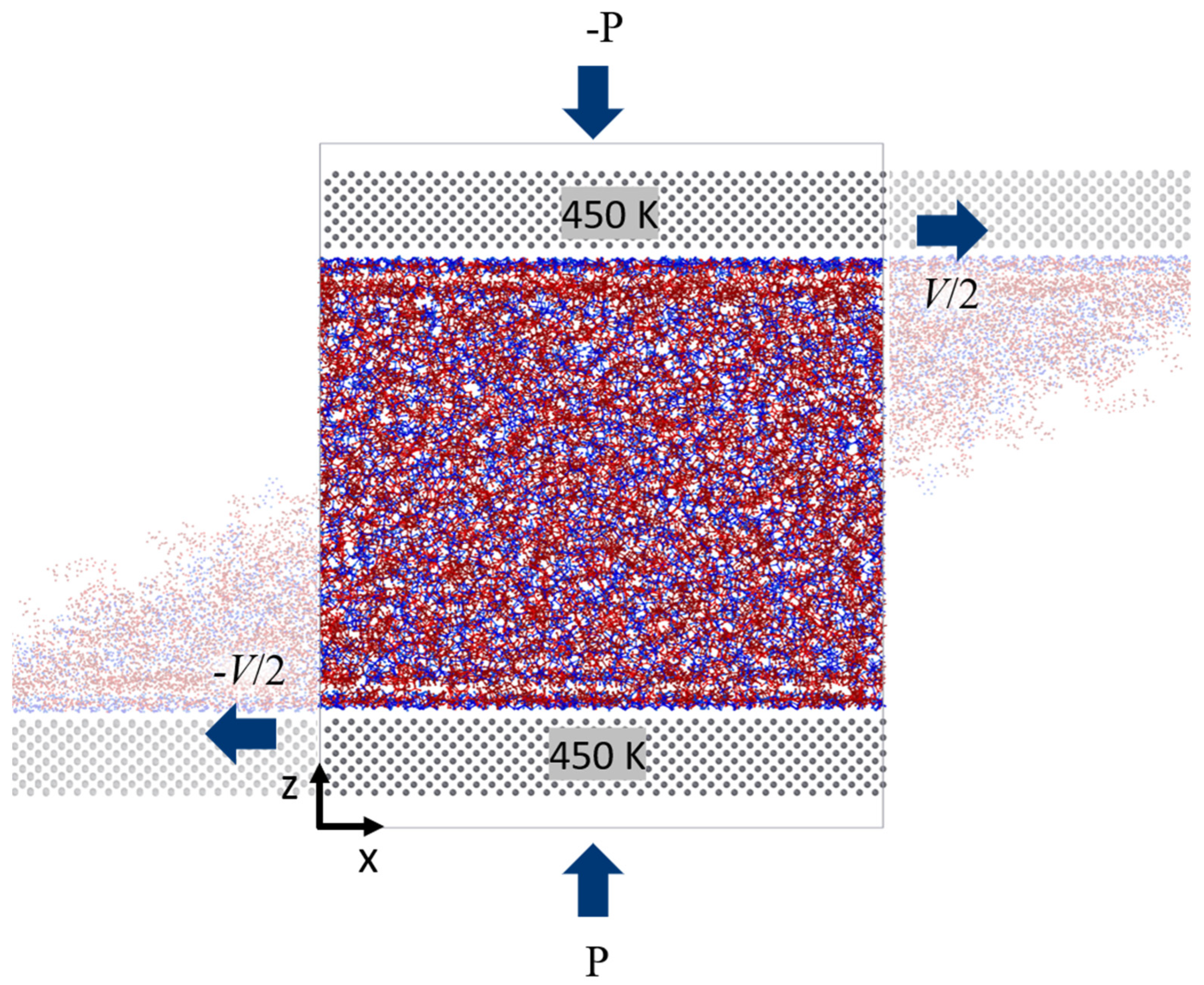
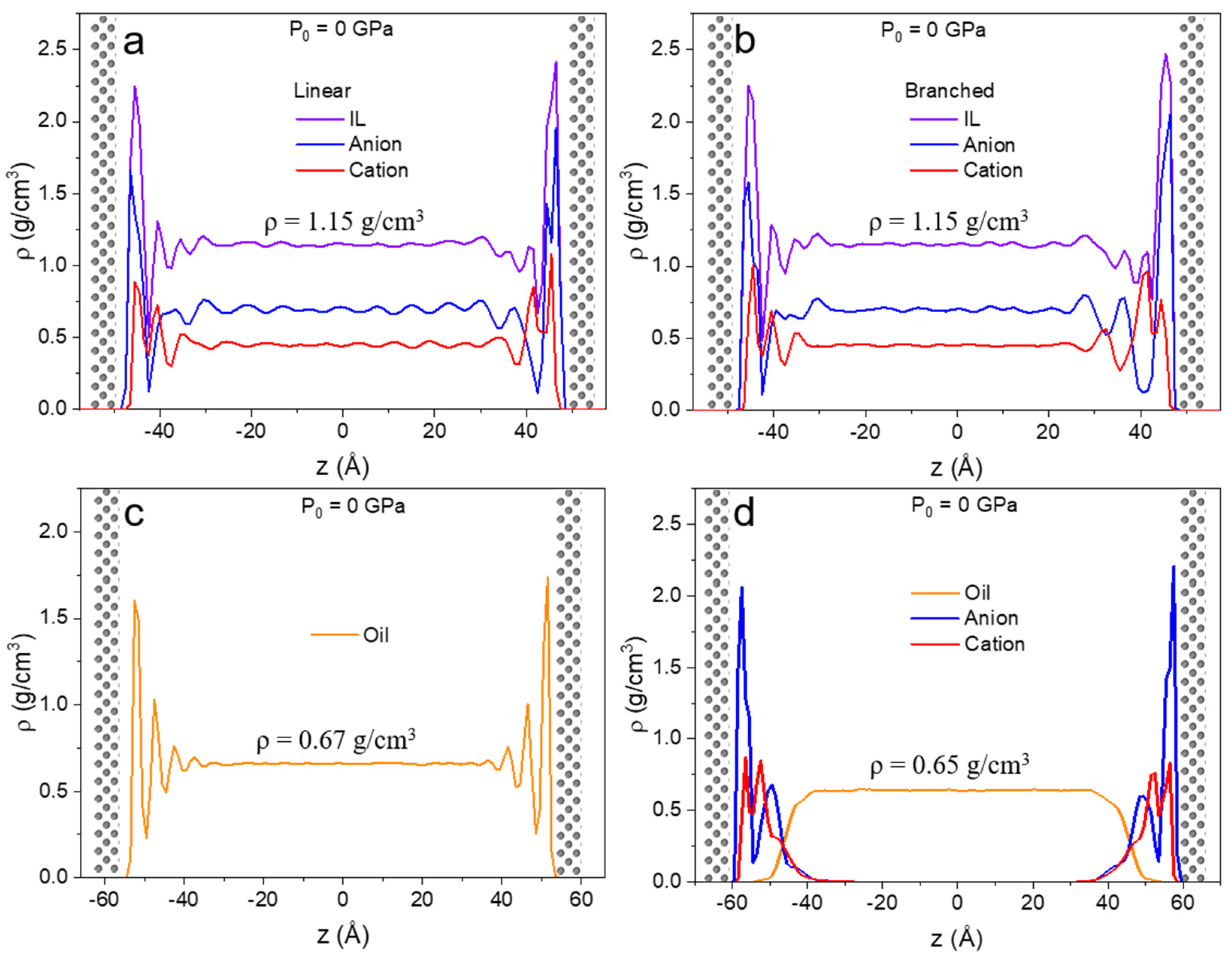

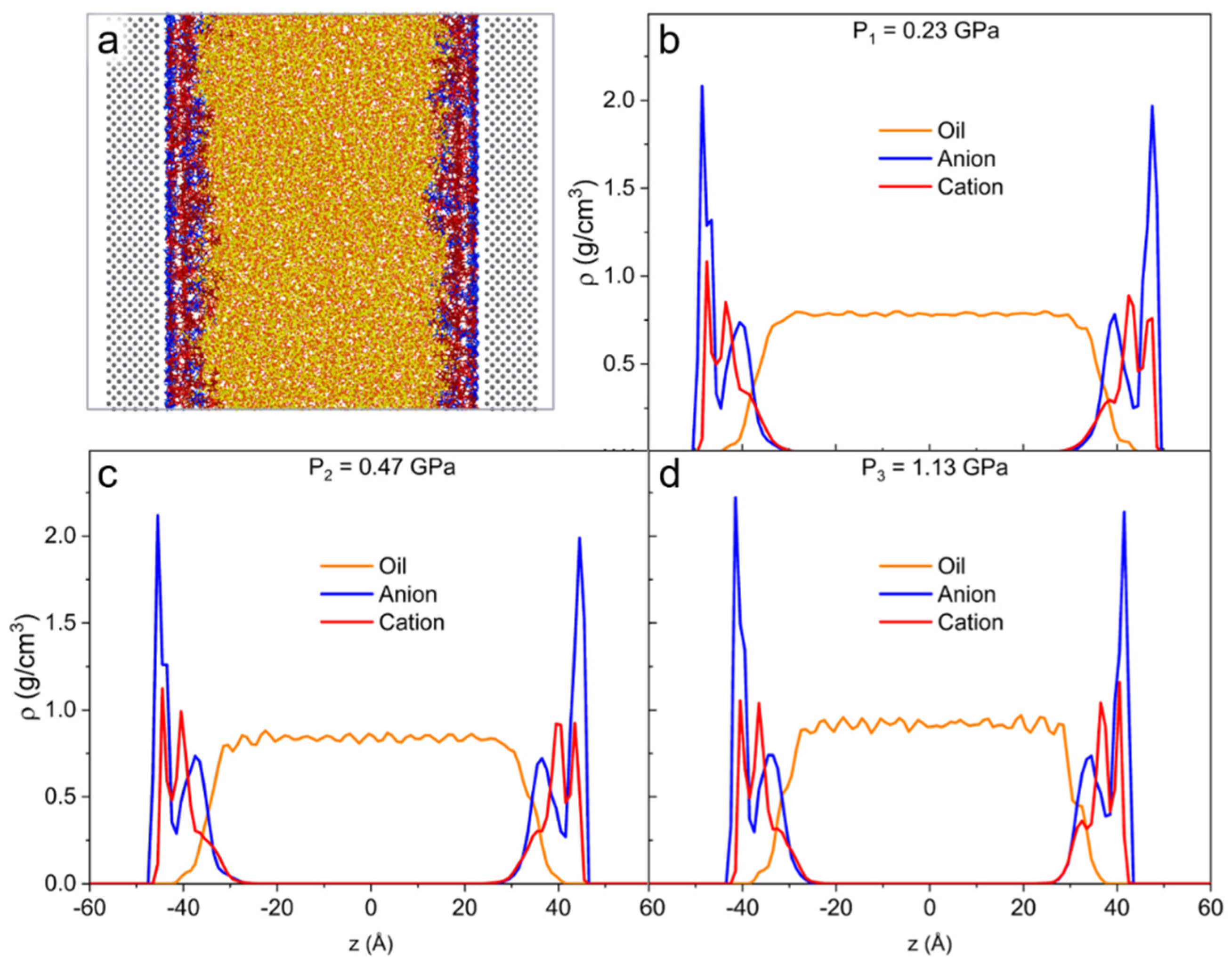

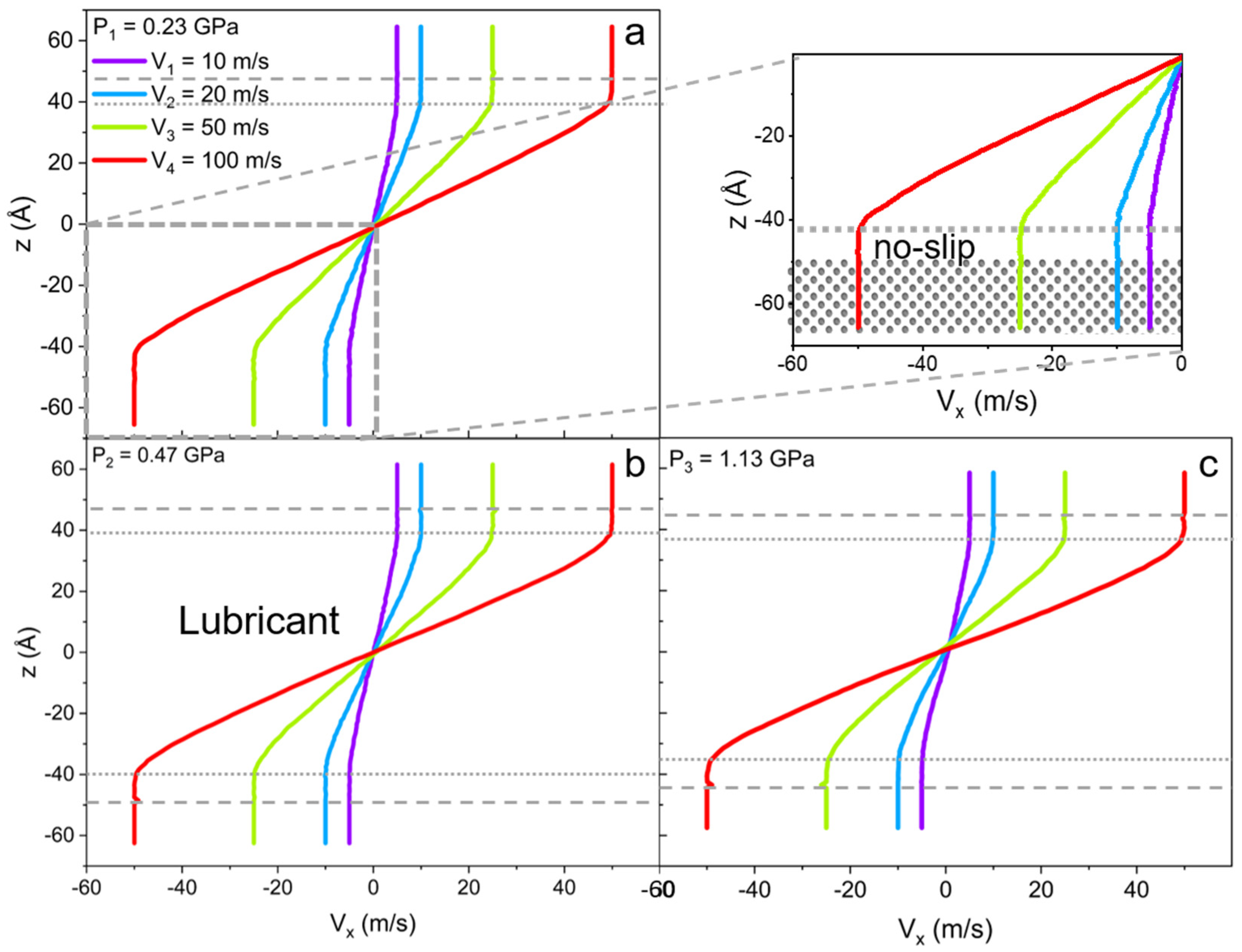

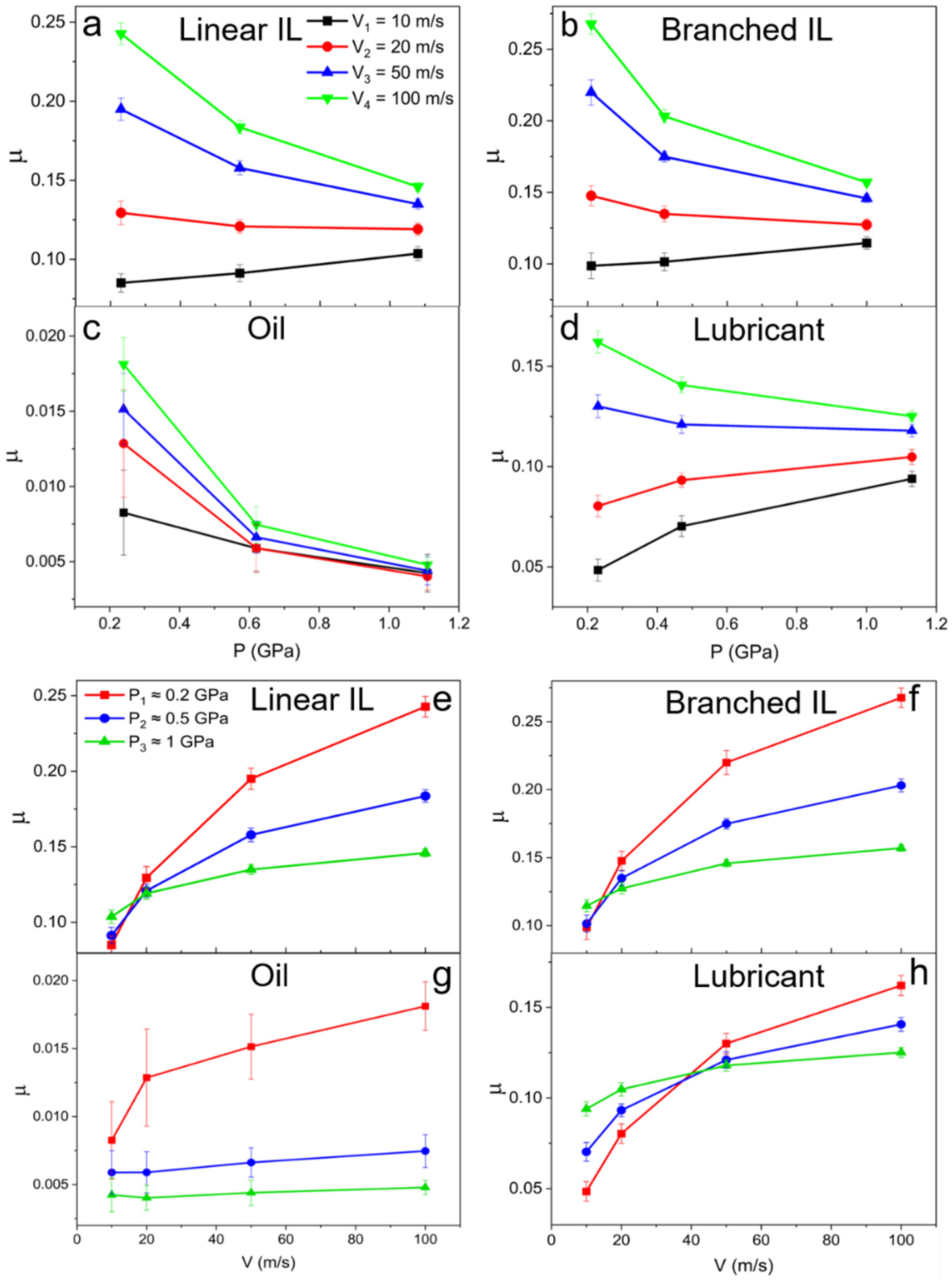
| System | P0 (GPa) | h0 (Å) | P1 (GPa) | h1 (Å) | P2 (GPa) | h2 (Å) | P3 (GPa) | h3 (Å) |
|---|---|---|---|---|---|---|---|---|
| IL1-Fe | 0.00 | 96 | 0.23 | 87 | 0.47 | 83 | 1.08 | 77 |
| IL2-Fe | 0.00 | 96 | 0.21 | 87 | 0.42 | 83 | 1.00 | 77 |
| Oil-Fe | 0.00 | 108 | 0.24 | 95 | 0.62 | 87 | 1.11 | 82 |
| Mix-Fe | 0.00 | 119 | 0.23 | 103 | 0.47 | 97 | 1.13 | 89 |
| System | ρ (g/cm3) at P1 | ρ (g/cm3) at P2 | ρ (g/cm3) at P3 |
|---|---|---|---|
| IL1-Fe | 1.32 | 1.40 | 1.52 |
| IL2-Fe | 1.32 | 1.39 | 1.50 |
| Oil-Fe | 0.79 | 0.87 | 0.92 |
| Mix-Fe (oil in bulk) | 0.78 | 0.84 | 0.92 |
| Velocity (m/s) | Pressure (GPa) | Linear IL | Branched IL | Oil | Lubricant |
|---|---|---|---|---|---|
| 10 | ≈0.2 | 0.0851 | 0.0987 | 0.0083 | 0.0484 |
| ≈0.5 | 0.0915 | 0.1015 | 0.0059 | 0.0703 | |
| ≈1.0 | 0.1033 | 0.1146 | 0.0042 | 0.0940 | |
| 20 | ≈0.2 | 0.1294 | 0.1477 | 0.0129 | 0.0804 |
| ≈0.5 | 0.1208 | 0.1350 | 0.0059 | 0.0932 | |
| ≈1.0 | 0.1191 | 0.1274 | 0.0040 | 0.1048 | |
| 50 | ≈0.2 | 0.1949 | 0.2200 | 0.0151 | 0.1291 |
| ≈0.5 | 0.1578 | 0.1749 | 0.0066 | 0.1210 | |
| ≈1.0 | 0.1349 | 0.1458 | 0.0044 | 0.1179 | |
| 100 | ≈0.2 | 0.2427 | 0.2676 | 0.0181 | 0.1621 |
| ≈0.5 | 0.1836 | 0.2031 | 0.00746 | 0.1407 | |
| ≈1.0 | 0.1459 | 0.1570 | 0.00479 | 0.1251 |
Publisher’s Note: MDPI stays neutral with regard to jurisdictional claims in published maps and institutional affiliations. |
© 2022 by the authors. Licensee MDPI, Basel, Switzerland. This article is an open access article distributed under the terms and conditions of the Creative Commons Attribution (CC BY) license (https://creativecommons.org/licenses/by/4.0/).
Share and Cite
Lazarenko, D.; Khabaz, F. A Molecular Dynamics Study on the Tribological Performance of Imidazolium−Based Ionic Liquids Mixed with Oil in Comparison to Pure Liquids. Fluids 2022, 7, 384. https://doi.org/10.3390/fluids7120384
Lazarenko D, Khabaz F. A Molecular Dynamics Study on the Tribological Performance of Imidazolium−Based Ionic Liquids Mixed with Oil in Comparison to Pure Liquids. Fluids. 2022; 7(12):384. https://doi.org/10.3390/fluids7120384
Chicago/Turabian StyleLazarenko, Daria, and Fardin Khabaz. 2022. "A Molecular Dynamics Study on the Tribological Performance of Imidazolium−Based Ionic Liquids Mixed with Oil in Comparison to Pure Liquids" Fluids 7, no. 12: 384. https://doi.org/10.3390/fluids7120384
APA StyleLazarenko, D., & Khabaz, F. (2022). A Molecular Dynamics Study on the Tribological Performance of Imidazolium−Based Ionic Liquids Mixed with Oil in Comparison to Pure Liquids. Fluids, 7(12), 384. https://doi.org/10.3390/fluids7120384






